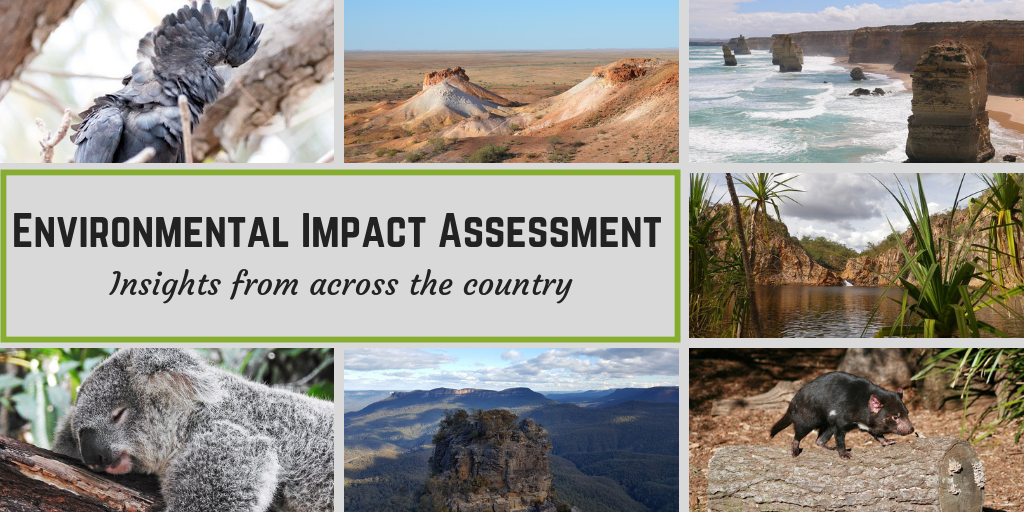Environmental Impact Assessment (EIA) is a formal process for guiding human activity towards sustainable development. It is a decision-making tool used globally to inform and guide development projects which will have an impact on natural systems. While EIA is a globally adopted practice, there is not a single method or approach to completing the assessment (Morrison-Saunders, 2018). Completing some form of EIA is a key component to all environmental approvals. This short document aims to draw some comparisons and similarities in approach to EIA from the States and Territories in Australia.
EIA – Brief Overview
The fundamental concept behind EIA is to examine the knowledge of the environmental setting in question before undertaking development with the premise of making better decisions that minimise environmental harm (Morrison-Saunders, 2018). Key aspects that are considered in EIA include:
- The nature of the development;
- The receiving environment;
- The potential risks or impacts to the environment from activities;
- Quantification of the significance of the predicted impacts, and
- Consideration of mitigation and environmental management measures.
(Morrison-Saunders, 2018)
Most importantly, the impact assessment must be based on sound science with any uncertainty specified.
EIA of Major Projects in Australia
Western Australia
 In Western Australia, major projects are assessed by the WA Environmental Protection Authority under the Environmental Protection Act 1986. Through the formal impact assessment process, the EPA will assess projects and make a recommendation to the Minister. As part of this process the proponent is required to prepare or assist in the preparation of a number of documents:
In Western Australia, major projects are assessed by the WA Environmental Protection Authority under the Environmental Protection Act 1986. Through the formal impact assessment process, the EPA will assess projects and make a recommendation to the Minister. As part of this process the proponent is required to prepare or assist in the preparation of a number of documents:
- Referral – this is the first document submitted to the EPA. Any proposal likely to have a significant environmental impact will need to be referred to the EPA through the preparation of a referral document and form. The referral should discuss the proposed project, scale and environmental impacts. There are several pathways of assessment should the EPA decide to assess a referred project.
- Additional Assessment Information – The proponent may be required to undertake additional studies and provide these to the EPA as part of the assessment. The assessment will then be made on the referred information and additional studies/assessment
- Environmental Review Document – The proponent must complete a formal environmental impact assessment through the compilation of an environmental review document. This must address key environmental factors which the EPA and proponent will identify through a scoping document. As part of this document environmental management plans may also be required to demonstrate how impacts will be managed. Depending on the level of assessments et the environmental review document may be available for public review and comment.
At completion of the assessment, the EPA will provide a report and recommendations on the proposal, its implementation (if approved or not) and conditions which the project will be subject to. To assist with the EIA process, the EPA has identified a number of environmental factors and objectives which the proponent needs to address. In WA economic impacts are not assessed through the EIA process. The EPA also highlights how ‘significance’ of impacts should be considered for various matters. Detailed information on the EIA process and environmental assessments in WA is provided on the WA EPA website. The EPA also has a range of guidance material to assist with the development of baseline environmental studies and EIA related documents. (EPA, 2016; EPA, 2018)
Northern Territory
 In the NT proposed actions which have the potential to have a significant impact on the environment require an EIA under the NT Environmental Assessment Act 1982 which is assessed by the NT Environmental Protection Authority, an independent authority. Proponents are required to prepare several documents which outline the proposed development and the potential environmental impacts. These include:
In the NT proposed actions which have the potential to have a significant impact on the environment require an EIA under the NT Environmental Assessment Act 1982 which is assessed by the NT Environmental Protection Authority, an independent authority. Proponents are required to prepare several documents which outline the proposed development and the potential environmental impacts. These include:
- Notice of Intent – this is the first document submitted to the NT EPA to notify of the proposed action. The Notice of Intent provides the details for the NT EPA to determine the level of assessment. It must include information such as the scale
- EIA Document – There are two streams of assessment in the NT: Public Environmental Review and Environmental Impact Statement. The level of assessment is determined by the number of environmental issues, magnitude and extent of impacts and interaction with nationally listed fauna, flora and habitats. Depending on the level of assessment set by the NT EPA, the proponent is required to compile the relevant EIA document for submission and assessment by the NT EPA. Under both pathways, the EIA document is available for public comment for 28 days.
- Further information as required – throughout the process proponents may be required to provide additional information on the project, environmental values and impacts.
To assist with the EIA process, the NT EPA has developed environmental factors and objectives which highlights the value associated with elements of the environment. Proponents are to address these within their EIA document. The NT EPA also use these factors and objectives to assist with determining the significance of a proposal and when assessing EIA documents.
Detailed information on the EIA process and environmental assessments in the NT is provided on the NT EPA website. (NT EPA, 2014; NT EPA, 2018b; NT EPA, 2018a).
Queensland
 In Queensland projects which involve a relatively high level of environmental risk often follow an Environmental Impact Statement (EIS) process. This process is usually undertaken for major resource projects such as mining and petroleum. The Queensland Department of Environment and Heritage Protection provides a document which lists ‘triggers’ for projects which may need to be assessed down the EIA pathway. Proponents are required to prepare several documents which outline the proposed development and the potential environmental impacts. These include:
In Queensland projects which involve a relatively high level of environmental risk often follow an Environmental Impact Statement (EIS) process. This process is usually undertaken for major resource projects such as mining and petroleum. The Queensland Department of Environment and Heritage Protection provides a document which lists ‘triggers’ for projects which may need to be assessed down the EIA pathway. Proponents are required to prepare several documents which outline the proposed development and the potential environmental impacts. These include:
- Terms of Reference – this is the first document submitted which sets out the content and requirements of the EIS. This document is reviewed by the department but is also available for public comment.
- EIS Document – This is the formal impact assessment document prepared for by the proponent. The EIS must include the scale, intensity, duration, frequency and irreversibility of the impact, and the risk of serious environmental harm, material environmental harm and environmental nuisance as well as expected adverse and beneficial environmental, social and economic impacts of the project. This document is available for public comment and consultation prior to the department completing their assessment and decision.
To assist with the EIS process the Queensland Department of Environment and Heritage Protection provides guidance materials on environmental and heritage factors which covers how baseline information on the values in an area must be collected to the required level. They also provide guidance material on the requirements, process and content of the EIS document.
Detailed information on the EIS process is provided on the Queensland Department of Environment and Heritage Protection website. (EHP; EHP)
New South Wales
 In New South Wales projects which are classified as a state significant development and are important to the state for economic, environmental or social reasons are assessed under the Environmental Planning and Assessment Act 1979. These projects are assessed by the Department of Planning and Environment and are evaluated against the triple bottom line. Proponents are required to prepare several documents which outline the proposed development and the potential environmental impacts. These include:
In New South Wales projects which are classified as a state significant development and are important to the state for economic, environmental or social reasons are assessed under the Environmental Planning and Assessment Act 1979. These projects are assessed by the Department of Planning and Environment and are evaluated against the triple bottom line. Proponents are required to prepare several documents which outline the proposed development and the potential environmental impacts. These include:
- Scoping Report – this is the first document prepared after consultation with the Department and the community. The Scoping Report outlines the project, consultation completed to date as well as the scale and nature of impacts. As an outcome form this document the Department will issue a document of the environmental assessment requirements.
- Environmental Impact Statement – the proponent, using the environmental assessment requirements document, must prepare an Environmental Impact Statement. The purpose of this document is to assess the economic, environmental and social impacts of the project. Impacts of the project must be assessed in relation to relevant government legislation, policies and guidance material. The EIS document is available online for public comment.
Once the Department has reviewed the EIS, it will prepare an assessment report which evaluates the merits of the project and includes recommended conditions of consent (if warranted).
The process of EIA in NSW is very detailed, and further information is available on the Major Projects webpage of the Department of Planning and Environment website. (Department of Planning and Environment, 2018)
Victoria
 In Victoria projects which will have a significant effect on the environment are assessed under the Environment Effects Act 1978. Under this Act, the Minister for Planning is involved in the decision-making process with input from the Impact Assessment Unit at the Department of Environment, Land, Water and Planning. In Victoria the formal EIA process informs other decision makers such as local governments to consider the Ministers assessment in deciding whether to approve activities related to the project. Proponents are required to prepare several documents which outline the proposed development and the potential environmental effects as part of the assessment process. These include:
In Victoria projects which will have a significant effect on the environment are assessed under the Environment Effects Act 1978. Under this Act, the Minister for Planning is involved in the decision-making process with input from the Impact Assessment Unit at the Department of Environment, Land, Water and Planning. In Victoria the formal EIA process informs other decision makers such as local governments to consider the Ministers assessment in deciding whether to approve activities related to the project. Proponents are required to prepare several documents which outline the proposed development and the potential environmental effects as part of the assessment process. These include:
- Referral – the proponent prepares documentation for the Minister which outlines the proposed project and the potential environmental, social and economic effects. The Minister will determine form the referral information if an Environmental Effects Statement is required. Should the Environmental Effects Statement be required, the Minister (with input from a Technical Reference Group) will issue a Scoping Document detailing the required inputs for this document.
- Environmental Effects Statement – The proponent must compile and submit the Environmental Effects Statement. This document must assess the projects potential effects on physical systems, ecological systems, human communities, land use and economic factors. Once the document has been submitted it is available for public comment and review.
In Victoria, the final step in the process is an assessment of the environmental effects of the Project. This stage is commonly referred to as the Ministerial Assessment. This decision is intended to inform and guide all other decision-making processes and must be considered by other government and statutory decision-making authorities when considering approvals for the project. Detailed information on the EIA process is provided on the Department of Environment, Land, Water and Planning website. There is also a detailed guidance document on the Environmental Effects Statement process including the factors which must be addressed in formal documents and are considered during the assessment (DELWP, 2006).
Tasmania
 In Tasmania, the Board of the Environment Protection Authority has statutory responsibility for environmental impact assessments which will have a significant impact on environmental quality. The assessment process commences through the referral of a project to the Board of the EPA by the proponent or the local council where the project will occur. Proponents are required to complete the following documents as part of the assessment process:
In Tasmania, the Board of the Environment Protection Authority has statutory responsibility for environmental impact assessments which will have a significant impact on environmental quality. The assessment process commences through the referral of a project to the Board of the EPA by the proponent or the local council where the project will occur. Proponents are required to complete the following documents as part of the assessment process:
- Notice of Intent – this is the first document submitted to the Board of the EPA and provides an overview of the proposed project and potential activities. The Board of the EPA determines the level of assessment based on this document.
- Case for Assessment – based on the level of assessment set by the Board of the EPA, the proponent will be required to prepare a document to allow the Board to assess environmental impact. The board prepares a Guidance document outlining what must be included in the case for assessment. The document submitted could be: Environmental Effects Report often used for low environmental risk projects where key environmental issues are limited or a Development Proposal and Environmental Management Plan which provides a detailed assessment of impacts and their management. Throughout this process, the EPA Tasmania are consulted and draft documents are reviewed. The final document is made available for public comment.
To assist proponents to develop their assessment documents the Board of the EPA has developed details guidance material outlining the format, structure and content for the case for assessment including the key environmental issues of interest (EPA Tasmania, 2013). Additional information is provided on the EPA Tasmania website.
South Australia
 In South Australia, major development projects are managed and assessed by the Development Act 1993 and the Department of Planning, Transport and Infrastructure. A project is classed as a major development if it is of state economic, social or environmental significance. Both the Minister and an independent statutory authority, the State Commission Assessment Panel, are involved in the decision and assessment of the proposal. The assessment process requires the proponent to develop or assist with the following documents:
In South Australia, major development projects are managed and assessed by the Development Act 1993 and the Department of Planning, Transport and Infrastructure. A project is classed as a major development if it is of state economic, social or environmental significance. Both the Minister and an independent statutory authority, the State Commission Assessment Panel, are involved in the decision and assessment of the proposal. The assessment process requires the proponent to develop or assist with the following documents:
- Project Declaration – the proponent provides a declaration or referral document which contains sufficient information on the details and scale of the project. This is reviewed by the State Commission Assessment Panel. If the project is deemed a major development, the Panel will set the level of assessment.
- Guidelines – the Panel with input from the proponent and other agencies, develops a document outlining the key social, environmental and economic issues relevant to the proposed project which will need to be addressed in the formal impact assessment document
- Assessment Document – there are three levels of assessment for major developments in SA. These include: Development Report which relies on existing information, Public Environmental Review which is a targeted assessment on select issues or Environmental Impact Statement which covers a range of issues to be investigated in depth. In all three pathways, there is an opportunity for public review and comment prior to the final decision.
To assist with the development of the above documents and assessment process, there is a list of example factors which may be considered to determine if a project is a major development or which may be the focus of an impact assessment.
Additional information is available through the SA government website. (DPTI, 2017)
Comparisons and Differences
The team at Integrate Sustainability has a wealth of knowledge and experience in environmental impact assessment in Western Australia. We understand that the formal environmental impact assessment process can be daunting and complex. If you require assistance compiling an impact assessment document for a project, are looking for guidance on the process, or are a community group seeking assistance, please contact us to see how we can help.
Download PDF: ISPL Insight – EIA in Australia
References
DPTI. (2017). Guide. Major Development Assessment South Australia’s Development ACt . A practical guide for proponents. Adelaide, SA: Department of Planning, Transport and Infrastructure. Retrieved from https://www.sa.gov.au/__data/assets/pdf_file/0010/200341/GUIDE-Major_Developments_Guide_for_Applicants_2017.PDF
EHP. (n.d.). Guideline The environmental impact statement process for resource projects under the Environmental Protection Act 1994. Brisbane, QLD: Queensland Government. Retrieved from https://environment.des.qld.gov.au/management/impact-assessment/eis-processes/documents/eis-process-guideline-em1375.pdf
EHP. (n.d.). Triggers for environmental impact statements under the Environmental Protection Act 1994 for mining and petroleum activities . Brisbane, QLD: Queensland Government. Retrieved from https://environment.des.qld.gov.au/management/impact-assessment/pdf/eis-guideline-trigger-criteria.pdf
EPA. (2016). Statement of Environmental Principles, Factors and Objectives. Perth, WA: Environmental Protection Authority.
EPA. (2018). Guidelines and Procedures. Retrieved from WA Environmental Protection Authority: http://epa.wa.gov.au/guidelines-and-procedures
EPA Tasmania. (2013). Guidance Documents. Retrieved from EPA Tasmania: https://epa.tas.gov.au/assessment/assessment-process/guidance-documents
Morrison-Saunders, A. (2018). Advanced Introduction to Environmental Impact Assessment. Cheltenham, UK: Edward ELgar Publishing Ltd.
NT EPA. (2014). Guide to the Environmental Impact Assessment Process in the Northern Territory. Darwin, NT: NT EPA. Retrieved from NT EPA: https://ntepa.nt.gov.au/__data/assets/pdf_file/0007/286756/Guide-to-EIA-Process-in-NT.pdf
NT EPA. (2018a). Northern Territory Environmental Impact Assessment Process. Darwin, NT: NT EPA. Retrieved from https://ntepa.nt.gov.au/__data/assets/pdf_file/0004/286753/eiaFlowchart.pdf
NT EPA. (2018b). NT EPA ENvironmental Factors and Objectives. Darwin, NT: NT EPA. Retrieved from https://ntepa.nt.gov.au/__data/assets/pdf_file/0005/546791/guideline_environmental_factors_objectives.pdf


